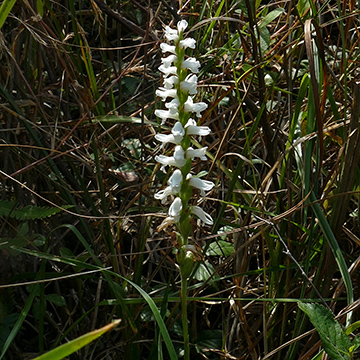

Spiranthes cernua - (image 1 of 7)
Taxonomy
Family: Orchidaceae
Habitat
Wet, open, low-statured graminoid-cyperoid sites, often with Sphagnum.
Associates
Distribution
Coastal Plain to the eastern and southern Appalachians, southern Interior Lowlands, and Cumberland Plateau. In NY appears to be restricted to the southern part of the state.
Morphology
Perennial to 100 cm. Leaves often present at anthesis; basal leaves narrow, to 22 cm; cauline sheaths 3-8, sometimes with a spreading-recurved blade. Inflorescence a terminal, spirally twisted, spike-like raceme 2-18 cm long; flowers crystalline-white, numerous, 6-12 mm long, in 1-4 vertical ranks, individually slightly to strongly nodding, becoming more so in age; lateral sepals lanceolate, acute to rather blunt-tipped, straight to scarcely falcate, angled slightly outward and upward; lip short-clawed, recurved strongly downward from about 1/3 its length, white to slightly pale yellow centrally, 7-13 mm long, apex acute to acuminate, the basal tubercles conical, upright, 1-2 mm long.
Notes
Flowers mid September to November
Wetland indicator: FACW
Typically faintly fragrant but varying from nearly odorless to moderately fragrant. This species is similar to other species in the complex, mainly differing in having a labellum that is thinner and less yellow centrally and with abaxial glands that are reduced and strongly flattened. The lateral sepals sometimes, but apparently not always, curve inward at the tips over the dorsal sepal and petals.
Sheviak (1982) proposed that S. cernua represents a polyploid compilospecies that incorporates genes from other species. A number of recently described polyploid species, representing likely prior hybridization (allopolyploidy) with the diploid species S. magnicamporum, S. ochroleuca, S. odorata, and S. ovalis, would seem to support this hypothesis.
Some of the images originally used for this page have been determined by genetics to be S. arcisepala. Therefore the images have been changed to only show those determined to be S. cernua from southern NJ and Staten Island, NY.
References
M. Hough and M.A. Young. 2021. A systematic survey of the Spiranthes cernua species complex (Orchidaceae) in New York. Native Orchid Conference Journal, 18(3): 22-56.
Pace, M.C. and Cameron, K.M. 2017. The systematics of the Spiranthes cernua species complex (Orchidaceae): Untangling the Gordian Knot. Systematic Botany, 42(4):1-30.
Sheviak, C.J. 1982. Biosystematic study of the Spiranthes cernua complex. New York State Museum Bulletin No. 448.
|
Michael Hough © 2018 |